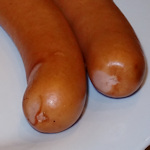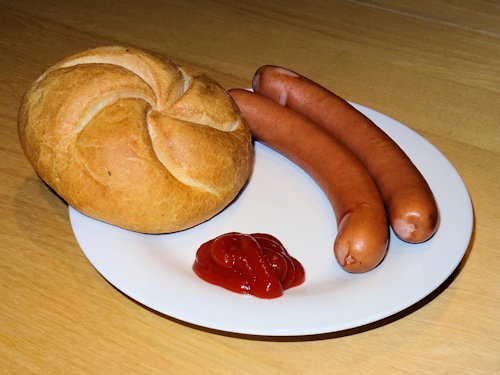
The ultimate quick meal in a Viennese household is to whack a couple of frankfurters into a pot of hot water, then down the results with a bit of bread and a dollop of mustard or ketchup.
- Austrian equivalent of the US wiener (or Vienna) sausage
- Available at sausage stands across the city and every grocery store
- Interesting variations are the upmarket Sacherwürstel and the artery-unfriendly Berner Würstel
- See also:
What is a Frankfurter?

(But where’s the mustard?))
The frankfurter is the Model T Ford of the Viennese sausage world. The plain pancake with no toppings. The simple espresso in the coffee shop of culinary delights.
Look on any price list hanging outside one of the Vienna sausage stands and the frankfurter usually sits up near the top. It’s likely the cheapest option, too. They tend to come in pairs accompanied by a plain white roll, mustard and ketchup.
But what is a frankfurter?
Well, it’s basically what North America knows as the wiener or Vienna sausage: a parboiled sausage made from pork, beef and other miscellaneous ingredients.
Unlike most of its fried colleagues on the sausage stand, the frankfurter is usually cooked in hot water before serving.
One story I’ve heard is that a butcher from Frankfurt invented the sausage while living in Vienna: hence the linguistic mix up. And you’ll find locals using the word wiener, too, though rarely (see below for more language shenanigans).
Now let me introduce you to two relatives of our humble snack…
The Sacherwürstel
The Sacherwürstel represents the more sophisticated version of the lowly frankfurter: longer, thinner, better-quality ingredients, and an urgent desire to discuss existentialist theory with you over a latte. This produces a slightly darker, more aromatic and a touch “crunchier” sausage.
The Berner Würstel
Another variation is the Berner Würstel.
You slice a frankfurter in half along its length, put cheese between the two halves, wrap this “frankfurter sandwich” in slices of bacon, then fry the result.
Needless to say, this rarely features in any lists headlined Top Ten Healthy Meals. If you can ignore the ingredients list and the likely consequences for your body, though, you’re in for a delicious treat.
The Berner Würstel is another linguistic trap, suggesting origins in the Swiss city of Bern. Nope. It first appeared in the Austrian winter resort of Zell am See. The cook’s name? Erich Berner.
Wiener? Frankfurter?
The word Wiener is actually German for a male from Vienna, and means precisely that locally. I’m now a Wiener by choice (I know how that sounds). My wife is a Wienerin (a female from Vienna).
Of course, the term Frankfurter also means someone from the German city of Frankfurt. I don’t know what they call the wiener/frankfurter sausage there.
Now, let’s add another layer of linguistic perplexity…
The German for sausage is Wurst. And Austria has something called Wienerwurst (often shortened to just Wiener), which literally translates as wiener sausage. This is a kind of sliced, processed meat popular in bread rolls.
And just to round off the confusion, mathematics has its own Wiener sausage, too (a representation of something called Brownian motion).
Incidentally, the wiener/frankfurter is not the only food with a confusing name. The German word Paprika, for example, is the spice of the same English name, but also the word for bell pepper.